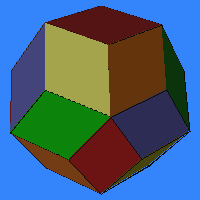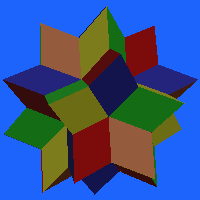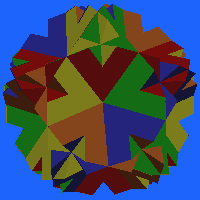Stellations of the Rhombic Triacontahedron
 The
process of stellation takes
a given polyhedron and extends its surface planes until they meet other
planes, resulting in a larger solid, a stellation of the interior solid.
This page describes the stellations of the rhombic
triacontahedron.
The
process of stellation takes
a given polyhedron and extends its surface planes until they meet other
planes, resulting in a larger solid, a stellation of the interior solid.
This page describes the stellations of the rhombic
triacontahedron.
Assuming reasonable conditions on what constitutes a stellation (called Miller's rules) there are 59 stellations of the icosahedron. By the same rules, it has been calculated that there are 358,833,072 stellations of the rhombic triacontahedron. I don't quite have disk space to show them all here. Of these millions, one can identify a manageable set of 226 fully supported stellations, meaning that there are no hollows between any point in the solid and its center. (Compare this to many of the 59 stellations of the icosahedron which have hollow centers.)
 One
of these 226 stellations of the rhombic triacontahedron is the familiar
compound of five cubes.
In reading the Introduction to Virtual Polyhedra,
you probably have already flown inside it and read the description
of the rhombic triacontahedron at its interior. Recall how the five
cubes define a symmetric coloring of
the rhombic triacontahedron in which five groups of six orthogonal faces
each share a color. I have rendered each of these stellated rhombic
triacontahedra with two different coloring schemes:
monochromatic and five colors. In the five-colored versions, for each color
there are six faces, arranged according to the planes of one of the five
cubes. This helps to make clear the common planes of different facets.
The one pictured at left here is interesting because it can be assembled
from 20 golden parallelepipeds. The
one pictured at right below is interesting because it has the special property
of having equal faces and equal
vertex figures.
One
of these 226 stellations of the rhombic triacontahedron is the familiar
compound of five cubes.
In reading the Introduction to Virtual Polyhedra,
you probably have already flown inside it and read the description
of the rhombic triacontahedron at its interior. Recall how the five
cubes define a symmetric coloring of
the rhombic triacontahedron in which five groups of six orthogonal faces
each share a color. I have rendered each of these stellated rhombic
triacontahedra with two different coloring schemes:
monochromatic and five colors. In the five-colored versions, for each color
there are six faces, arranged according to the planes of one of the five
cubes. This helps to make clear the common planes of different facets.
The one pictured at left here is interesting because it can be assembled
from 20 golden parallelepipeds. The
one pictured at right below is interesting because it has the special property
of having equal faces and equal
vertex figures.
Here are a few interesting cases, which only begin to illustrate the variety of forms:
- the first stellation, A, (solid color) (5 colors)
- the compound of five cubes, EF, (solid color) (5 colors)
- twenty rhombic parallelepipeds, U, (solid color) (5 colors)
- a lumpy one, RSTU, (solid color) (5 colors)
- a chiral example, Kr, (solid color) (5 colors)
- another chiral example, QrSrVrXr, (solid color) (5 colors)
- one with equal faces and equal vertex figures, K, (solid color) (5 colors)
- the final stellation, 2B, (solid color) (5 colors)
 The
letters which are used to name these stellations and the algorithm used
here for constructing these models are explained in Peter W. Messer's article
Stellations of the Rhombic Triacontahedron and Beyond, listed in
the references.
The
letters which are used to name these stellations and the algorithm used
here for constructing these models are explained in Peter W. Messer's article
Stellations of the Rhombic Triacontahedron and Beyond, listed in
the references.
And here is a list of stellations of the
rhombic triacontahedron.